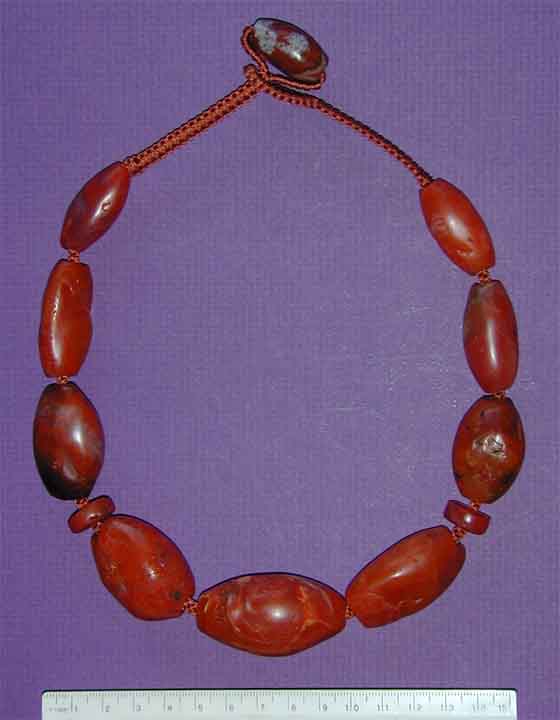| Pema Raka Beads - Old - Imitation - New | |||||
| Re: Re: Tibetan Coral Beads -- Beadman | Post Reply | Edit | Forum | Where am I? | |
11/12/2007, 14:35:56
The upper (or left) image shows five beads in my collection. The upper left bead is an authentic old pema raka bead from Tibet that I bought in the 1980s. Early pema raka beads are characterized by deriving from a particular quality of agate that is fairly opaque, and has a color on the side of being orange-brown. Some beads display quartz fortification zones—these being areas that have white and/or crystalline banding, usually in a closed pattern (a "fortification"). These areas might be small and unobtrusive, or they may be large and compose a significant part of the bead. The perforations of old pema raka beads tend to be reasonably large, as suits their reported use as "hair beads." They generally look like old beads, being gnarly, and distressed.
I believe that the material is essentially Chinese, because I have documented carvings from old China of this same material, some of which date from the Ming Dynasty. I'd like to think the pema raka beads are around that old. In addition to the "nodule" shape of these beads, this same material was cut into melon-form beads, as wells as thick disks, some of which appear in Himalayan prayer beads.
To the left of the above specimen is a GLASS imitation that I also bought (in San Francisco) in the 1980s. I don't know who may have made it, but I'd guess China is a possibility. It is the only glass pema raka bead I have ever seen. Apart from lacking any markings that imitate the convolutions of an agate stone, it is a very reasonable copy of a pema raka, in terms of size, shape, and color.
The three lower beads are new copies of peme raka beads that I bought in the late 1980s. These are from China, and appear to have been made from the same material—excepting only that they tend to be more translucent than older beads. (This also implies to me a Chinese origin for the source of the agate.) For some unknown reason, the reproduction pema raka beads have one large aperture on one end of the bead, and a smaller aperture on the other end. Most of the perforation channel is thinner, except for that larger one that penetrates only about 1/2 an inch into the bead. These were clearly not made to be "hair beads." If the Chinese have continued to make reproductions, there is every possibility these are more authentic-looking now. They may even be artificially distressed to look old....
The second photo is a necklace of old pema raka beads that I made for a client a few years ago. Note the thick disk beads included. The clasp bead is not a pema raka, but rather a jasper.
Jamey


Modified by Beadman at Mon, Nov 12, 2007, 14:38:54
All rights reserved by Bead Collector Network and its users
|